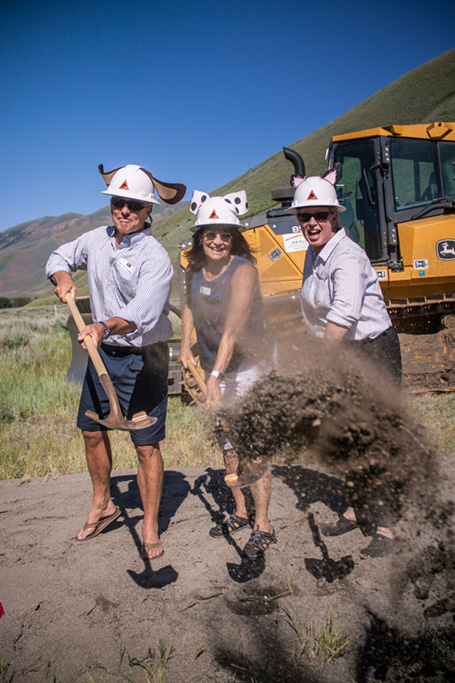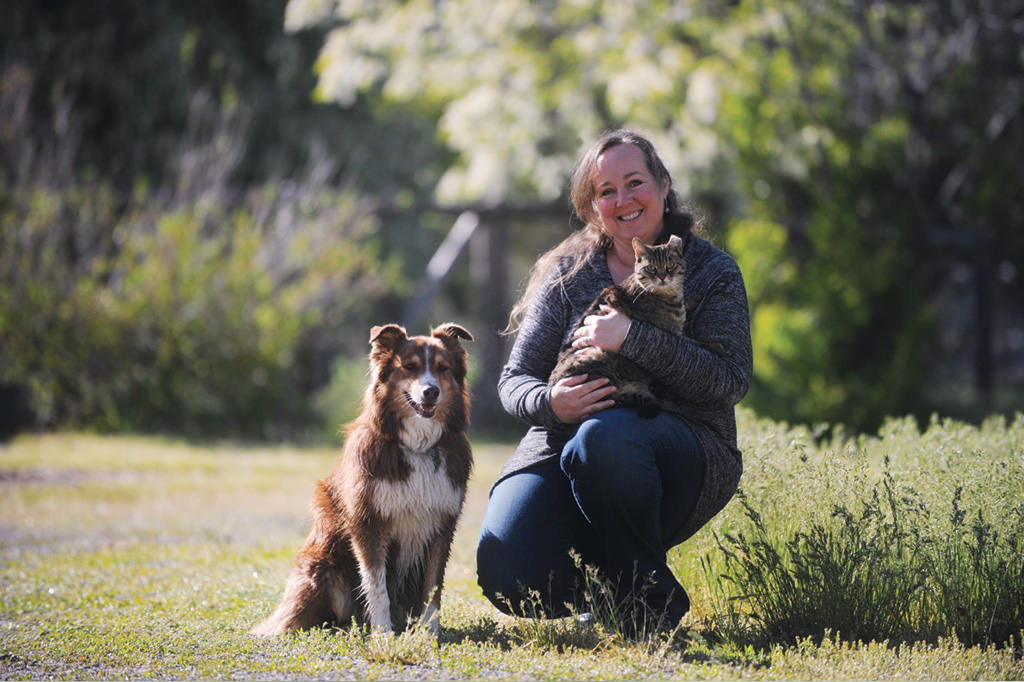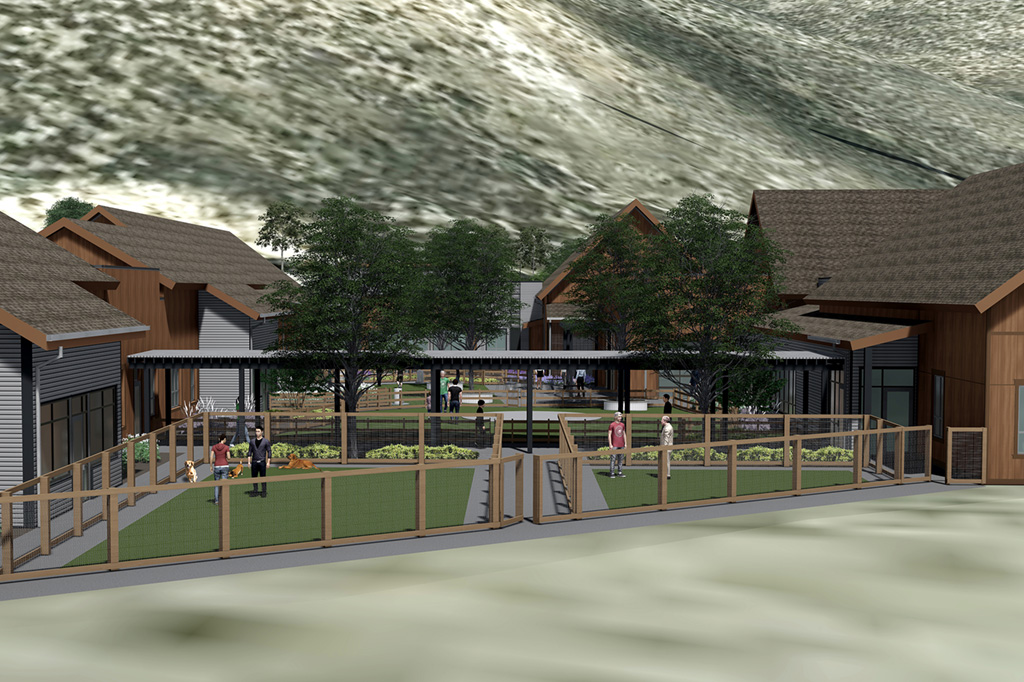For more than 35 years, the staff and volunteers at the Animal Shelter of the Wood River Valley have lovingly cared for lost, unwanted, and neglected animals in its humble Hailey, Idaho facility. However, over the years, the original facility, which has suffered near-fire, mudslide and floodwater damage, has become inadequate for the increasing number of rescued animals that come through its doors.
As Brooke Bonner, associate director of the shelter, described, “It is literally held together by duct tape and zip ties.”
And so, with the support of thousands of donors and hundreds of volunteers in the Wood River Valley and throughout the country, the Animal Shelter has taken on a monumental yet highly successful capital campaign to create what is being called an expanded animal welfare campus. Once completed, it will nearly double the current capacity for dogs and cats and allow for triple the number of annual adoptions, which last year reached a record 629.

Board members Greg Cappel and Priscilla Pittiglio with Executive Director Jo-Anne Dixon, DVM, at the June groundbreaking
The shelter broke ground on the new 30,000-square-foot facility this past June to the enthusiastic attendance of more than 100 campaign donors and volunteers. The facility, which will be sited on a 20-acre parcel across the street from its old location in Croy Canyon west of Hailey, has a fundraising goal of $16 million. So far, donations have come from people in nearly every state, many from people who adopted animals from the shelter in the past.
More Than a Shelter
When the facility opens its doors in late 2018, it won’t be just a place for homeless dogs and cats to wait out their time to be adopted. No, it will be a state- of-the-art training, living, and healthcare environment for the resident animals, and will have planned spaces for the public to interact with the animals and attend community events.
“We’re trying to create an animal welfare campus that is much more than just a shelter,” said Jo-Ann Dixon, DVM, executive director and medical director of the shelter. “It will also be a community gathering place for people who want to share that human-animal bond, learn about compassion and about caring for something other than themselves.”
Built around a central courtyard, the facility will have a spay/neuter center, adoption center, and an indoor training and acquaintance center where training classes and other animal-related activities can occur year-round. It will feature an outdoor events patio; an “Education Barn” for classes, workshops, and other public events; a “Cat Café” where visitors can socialize with resident felines; and outdoor “catios” where cats can sun themselves. The “Central Bark” courtyard and the outdoor play yards will be a landscaped area for on-leash dog walks, and a fenced yard for off-leash play and exercise.
A History of Meeting its Challenges
Over the past three-plus decades, the small shelter has seen its share of challenges. In 2013, the Beaver Creek Fire came roaring toward the shelter and got so close that flames were nearly licking at the outside walls. Bonner said that the animals had all been evacuated earlier, and with a last-ditch effort by firefighters, the shelter was saved from the fire. But, afterwards, with all the vegetation in the area burned away, the ensuing rains brought mudslides and flooding, destroying some empty kennels but thankfully not harming any animals.
“Our current facility was never designed to do what we’re doing today,” Bonner said. “Back in the old days when it was built, animals would get reclaimed in three days, adopted out, or euthanized. That’s no longer the case, thankfully.”
In 1999, the shelter became the first no-kill shelter in the state of Idaho and has today become a lifesaving destination for dogs and cats from other overcrowded, high-kill shelters around the country. Often, animals are flown in from other states by volunteer organizations such as Dog Is My Co-Pilot, and Wings of Rescue, which are operated by private pilots who transport the animals at no charge.
“As a vet, the last thing I want to do is kill animals; I want to save them,” said Dixon. “Our goal is, how do we do this so that no one in our community has to ever have a job of killing animals, because that is not a humane community where that happens. That’s why we started our no-cost spay and neuter program for any animal in Blaine County in 2006. We’ve now stabilized our animal population and are able to reach out to other shelters who are in crisis and whose numbers are overwhelming. About 40 percent of our animals come from high-kill shelters.”
In spite of the duct tape and zip ties holding the small, outdated shelter together, the people who manage it and care for the animals have continued to build its programs and offerings, making it the number-one-rated animal welfare organization in the region. The shelter offers a robust youth education program through local schools to teach children about animals, and partners with many other local groups and nonprofits such as The Hunger Coalition, The Advocates, and The Senior Connection.

Brooke Bonner, associate director of the shelter. Photo by Kirsten Shultz
A Destination Shelter
This focus on compassion and community engagement has made the shelter a destination trip for people throughout the country looking to adopt an animal. Currently, “shelter alumni” animals live in 37 states and Canada, and Bonner and Dixon explained that it is not unusual for people in other states to travel to Hailey to specifically adopt an animal from the shelter.
“Last week, a woman traveled down from Montana to adopt Bob, an adorable older black Lab with a grey muzzle,” said Bonner. “The woman works for Meals on Wheels, and Bob, the senior dog, is going to get to ride around delivering meals to senior citizens. It’s just beautiful. This happens literally every week.”
Dixon said the Animal Shelter serves a key role in helping Blaine County be a humane community for all. “In addition to saving homeless animals’ lives, we also help keep families together by providing services so they can keep their pets during times of struggle, and provide love and companionship to seniors and others through our outreach programs.
“When we say that it’s time for a new shelter, it’s not just a want; this is not something of a luxury,” said Bonner. “We are doing amazing things at this facility, and it’s time for a shelter that reflects the quality of our programs, the quality of the organization and the quality of our community.”
Added Dixon, “Building a humane community is what we’re all about, and that involves people as much as animals. Animals make our lives better; they give as much to us as we give to them. This really is about investing in and making this a better community for all of us.”


